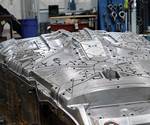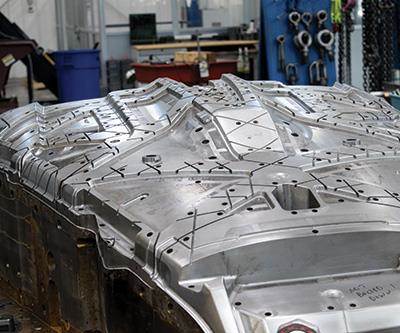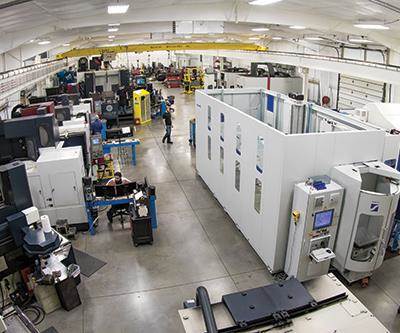Leadtime Leader Q&A: Krieger Craftsmen and MSI Mold Builders
We invited last year’s Leadtime Leader winner and honorable mention shops to share some of their thoughts about some hot industry topics.
How do you define “data-driven manufacturing?”
Krieger: It is the collection and documenting of information in an organized fashion, so you can easily continue to add to it and use it to make informed decisions. Everything requires data, including a mold design that allows delivery of the highest quality and most robust mold, with proper draft angles for shutoffs and steel conditions to endure millions of cycles.
Bral: Data-driven manufacturing comes down to using the best information you have to make the best, most informed decision that you can. We’ve probably all heard the saying, “Without data, you’re just another person with an opinion.” For me, that holds true, because the data should guide you the right way in scenarios where you have enough of it to make a good decision. A lot of disagreements over a decision can be attributed to not having enough clear information.
How does it apply to your company’s operations?
Krieger: We use the E2 ERP (enterprise resource planning) system to track all work through our shop, as well as for cost analysis. We have workcenters and machining centers, and our employees use 16 terminals in the shop to record their time, jobs worked on, etc. We monitor how many hours go into a job, how much we outsource and why, and how much it costs us. For example, although third-party metrology services are not overly expensive, all the preparation and freight it takes to ship the mold and then wait for the results is very time-consuming. We do that in house with our new Faro blue-light laser scanner that generates 400,000 points per second and reverse engineering software. Using the data collected helps us create the 3D CAD model of the mold. Following approval, the design moves to the CAM arena where we apply best practices and experiential knowledge to create cutter paths, including EDMing the finished tool. It’s all data-driven.
Bral: It certainly plays into our shopfloor improvements. We determine and solve bottlenecks in our operations, such as when one department is regularly behind its due dates and another has the most overtime but struggles to get product through. We use data to decide how to improve this kind of situation, perhaps adding people, another shift or a new machine. Although all of these options might be viable, only one will make the most sense based on what the numbers tell you. We also use data to improve our design processes, evaluting how to reduce lead times in engineering without sacrificing quality, for example. We establish baselines and use value stream mapping to see what’s critical and what’s not. Then we revisit them to see if the needle has moved in the right direction.
Where do you see data-driven manufacturing going in the next three to five years?
Krieger: As we continue to add information to our database, it will help guide us in procuring the latest technology and give us a competitive edge. I believe there will be better and more user-friendly applications developed in ERP, CAD and CAM, allowing us to continue to be more productive.
Bral: I think the future value of data-based improvements lies in some of the “softer” areas, such as sales, customer relationships and market changes, where data has not been as plentiful, is harder to get or hasn’t shown statistical significance in the past. You can create robust plans based on the appropriate responses you make to certain changes in market conditions, for example. You can have a sales plan that says how best (statistically) to handle a market, an account or even a person. I define “best” as what is statistically best, because it’s not going to be the best decision in every scenario, but it’s the decision that is most likely to give you the desired outcome. You are making the decision that gives you the best long-term outcome.
MSI Mold Builders
Related Content
MMT Chats: Solving Schedule and Capacity Challenges With ERP
For this MMT Chat, my guests hail from Omega Tool of Menomonee Falls, Wisconsin, who share their journey with using enterprise resource planning (ERP)—and their people—to solve their schedule and capacity load monitoring challenges.
Read MoreDynamic Tool Corporation – Creating the Team to Move Moldmaking Into the Future
For 40+ years, Dynamic Tool Corp. has offered precision tooling, emphasizing education, mentoring and innovation. The company is committed to excellence, integrity, safety and customer service, as well as inspiring growth and quality in manufacturing.
Read MoreTop 10 Topics to Cover During an ISO 9001 Manufacturing Audit
Take a look at this practical hands-on approach to conducting a quality audit.
Read MoreMMT Chats: 4 Keys to a Successful Mold-Building Operation: Innovation, Transparency, Accessibility and Relationship
MoldMaking Technology Editorial Director Christina Fuges chats with Steve Michon, co-owner of Zero Tolerance in Clinton Township, Michigan, about the excitement of solving problems, the benefits of showing gratitude, the real struggle with delegation and the importance of staying on top of technology. This episode is brought to you by ISCAR with New Ideas for Machining Intelligently.
Read MoreRead Next
2016 Leadtime Leader Awards HM: MSI Mold Builders - Optimizing Lead Times
This mold manufacturer combines continuous improvement strategies with machining power to maximize growth and opportunity.
Read More2016 Leadtime Leader Awards Winner: Krieger Craftsmen
This mold manufacturer was rebuilt with an emphasis on core values and a “productionized” moldmaking strategy designed to reduce lead times.
Read MoreAre You a Moldmaker Considering 3D Printing? Consider the 3D Printing Workshop at NPE2024
Presentations will cover 3D printing for mold tooling, material innovation, product development, bridge production and full-scale, high-volume additive manufacturing.
Read More




















